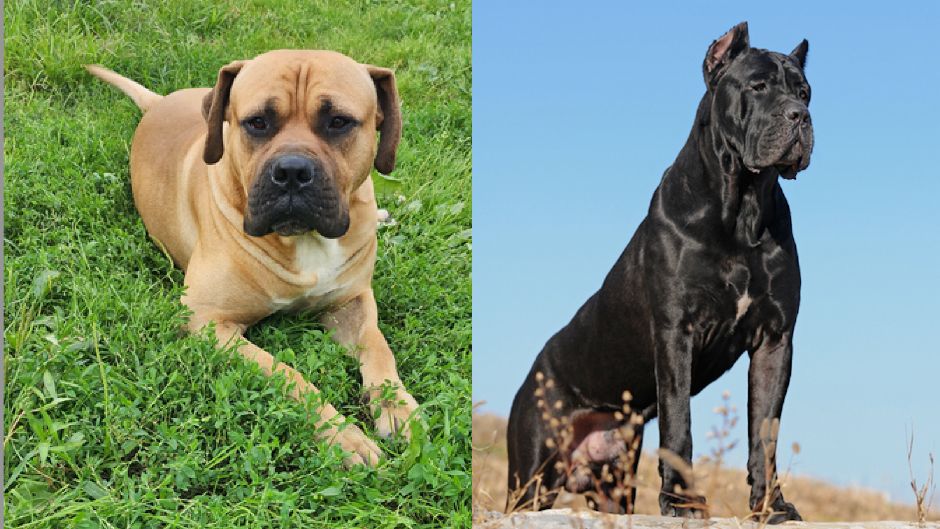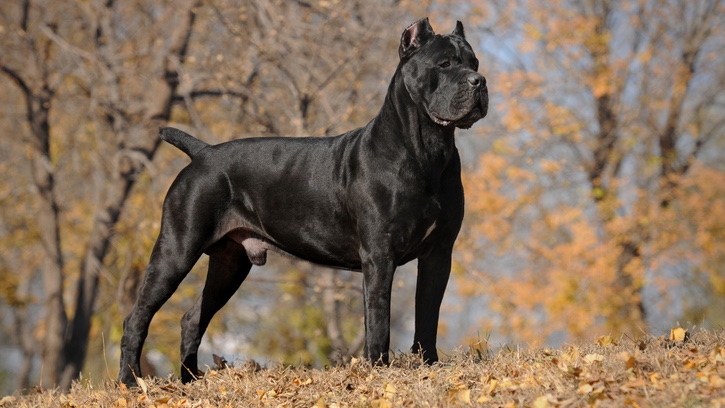Cane Corso vs Boerboel: Which breed should you choose?
Both come with a reputation but knowing the subtle differences between the Cane Corso vs Boerboel will help you find the perfect protective pal

If you’re interested in knowing the differences between the Cane Corso vs Boerboel, prepare to be surprised. There are actually many more similarities between these two breeds than you may imagine.
Both are large and muscular thanks to being a type of Mastiff, for example. They are also loyal, affectionate and incredibly intelligent. But because they have a natural tendency to be assertive, dominant, and wilful, you also need to know how to feed their needs to handle them appropriately.
Neither of these breeds are suitable for novice owners and, as as some of the guard dog breeds, they must be trained well and socialized from a young age. That way, they’ll rub along quite nicely with other dogs and people. If you’re capable of meeting the challenges, though, you’ll be richly rewarded.
So let’s get the lowdown on Cane Corso vs Boerboel and see which of the two breeds may be more suitable for you. By the end, having considered their strengths, smarts, grooming and exercise needs, you should have sufficient information to go one way or the other, particularly if you’re seeking a protective pal to watch over you and your family or after a dog who is very loving and eager to please.
Cane Corso vs Boerboel: Origins
The Cane Corso is part of a subcategory of breeds known as the Molossus once popular in Ancient Greece because of their guarding instincts. When the Romans invaded, they took some of these dogs back to Italy and bred them with native Italian breeds. They initially accompanied soldiers into battle and were later used by farmers to protect livestock.
The Boerboel, by contrast, hails from South Africa, where many settlers introduced large guard dogs for hunting and protection. Breeding with other mastiffs and bulldogs led to the breed's development and, just as Italian farmers loved the Cane Corso for their guarding instinct, the South African farmers sought to protect their homesteads from predatory animals.
Cane Corso vs Boerboel: Size and appearance
There are many similarities in terms of the appearance of these breeds. They have square-shaped heads and a long, broad muzzle and they are roughly the same size – each grow to roughly 28 inches (71cm) in height.
Get the best advice, tips and top tech for your beloved Pets
The Boerboel is bulkier and they can grow to twice the weight of a Cane Corso. That's not to say the Cane Corso isn't muscular – far from it – but the Boerboel can look more imposing and stocky simply because of that extra weight.
Otherwise, the main differences are color and coat. Boerboel fur is short and smooth whereas a Cane Corso's coat is short yet thicker and stiffer. Boerboels are usually lighter in color but the Cane Corso also tends to be black, even though there are red, fawn, and gray colors too. Interestingly, one Cane Corso fact shows how lifespan may be linked to color, so bear that in mind.
Cane Corso vs Boerboel: Bite force
Both dogs have strong jaws. The Cane Corso has a 700 psi bite force which is enough to crush a house brick. The Boerboel has a bite force of 450 psi (humans have a bite force of 162 psi, with 450 PSI being stronger than a grey wolf and on par with a black piranha.
Cane Corso vs Boerboel: Exercise needs

Both breeds need a lot of exercise, both mentally and physically. If they are not kept busy, they will become destructive, which is why giving them the best dog chew toys, for instance, will be as important as taking them out for an hour's walk each day.
Of the two breeds, the Boerboel is more agile but both have high prey drives and need to be kept on a lead when you're out and about. If you are considering either breed, you ideally need a secure, fenced backyard in which they can run around. You also need a decent amount of indoor space as well. Both are big dogs and they dislike small spaces. Neither of them are the best large dogs for apartments.
Cane Corso vs Boerboel: Grooming
If you are wondering “do Cane Corsos shed?” or think the same of Boerboels, rest assured that shedding is moderate and nowhere near as much as other larger breeds. Indeed, both breeds are relatively low maintenance thanks to their short coats so weekly brushing with one of the best dog brushes will do the trick, helping avoid masses of hair spreading across your furnishing and clothes.
Other than that, invest in the best dog nail clippers and keep their teeth clean. One thing's for sure, you won't be spending a fortune on grooming, so if you're pondering how much does owning a Cane Corso cost?, for instance, then you can at least cross this off the list.
Is a Cane Corso stronger than a Boerboel?
The Boerboel has good muscle development and is the stockier of the two breeds, which gives it the edge in terms of strength. The Boerboel is also mentally tougher – this breed is confident and protective with a distinct lack of fear.
That said, a Cane Corso tends to react to a potential danger more quickly than a Boerboel, which usually waits and assesses a situation before acting. It can make a Cane Corso more uncontrollable which, given their strength, could be dangerous. Training is key.
Are Cane Corsos smarter than Boerboels?
When Stanley Coren, professor of canine psychology at the University of British Columbia, wrote his book, The Intelligence of Dogs, in 1994, he didn't specifically include either the Cane Corso or the Boerboel. But he found that Mastiffs were among the lowest degree of working and obedience intelligence which is frustrating because Cane Corso and Boerboel breeds are known to be very smart indeed.
Which one should you choose?
Both breeds are quick to learn but they also need experienced, confident, and consistent owners. Without sufficient mental stimulation, they soon become bored and destructive, which means it's hard to leave them alone for lengthy periods. As for which is smarter than the other, we'd have to call it a draw. There really is very little between them.

David Crookes has been a journalist for almost 30 years and he has written for a host of magazines, newspapers, websites and books including the World of Animals Annual, BBC Earth, Live Science, The Independent and Tom’s Guide.
Born in England, he lives with two cats but he’s also keenly interested in the differences between the huge number of dog breeds – in fact, you can read many of his breed guides that he’s written in collaboration with vets here on PetsRadar.
With a lifelong passion for technology, too, he’s always on the lookout for useful devices that will allow people to keep their pets happier and healthier, and provide them more time to spend together.
David has a degree from Durham University, as well as postgraduate diploma in journalism from the University of Central Lancashire.
